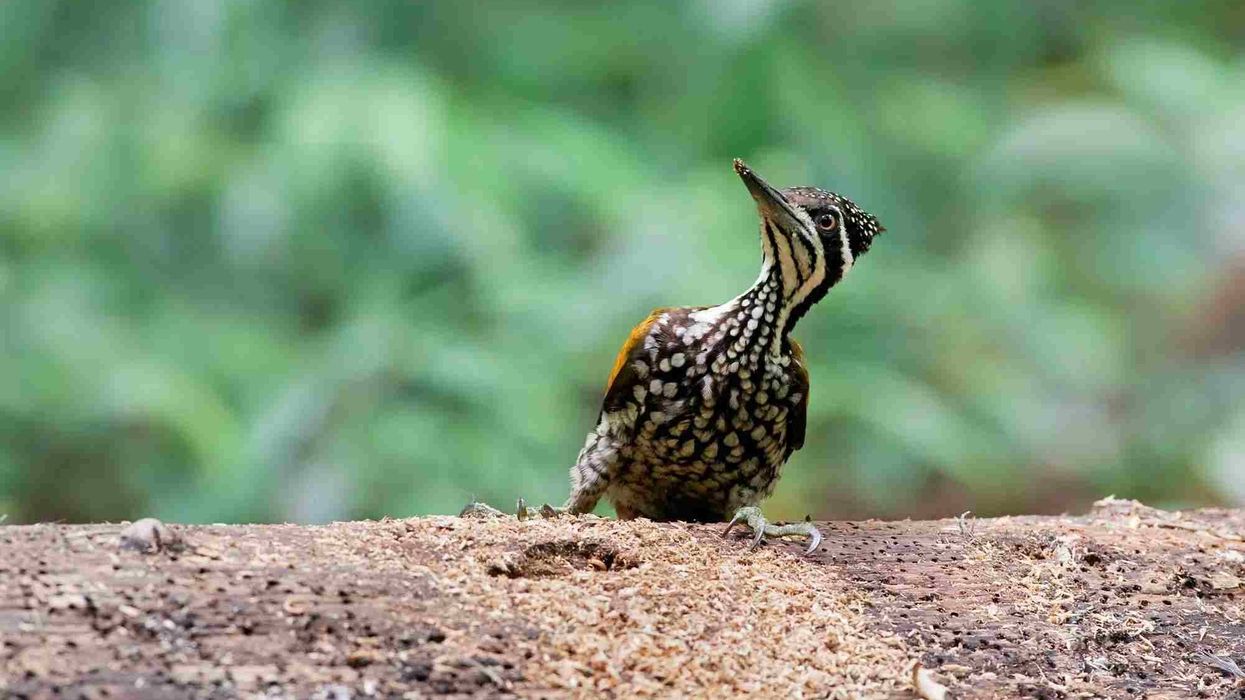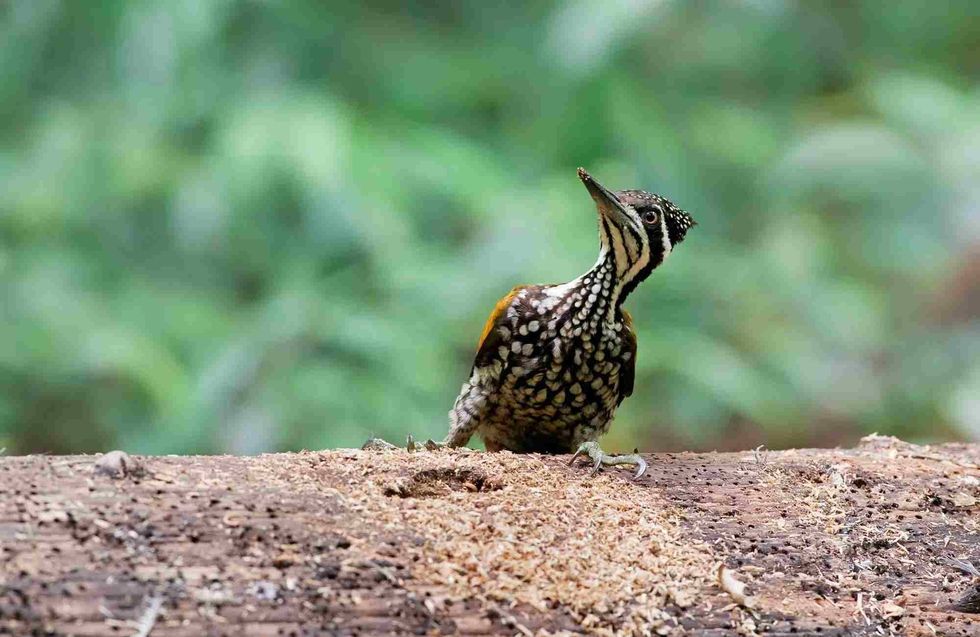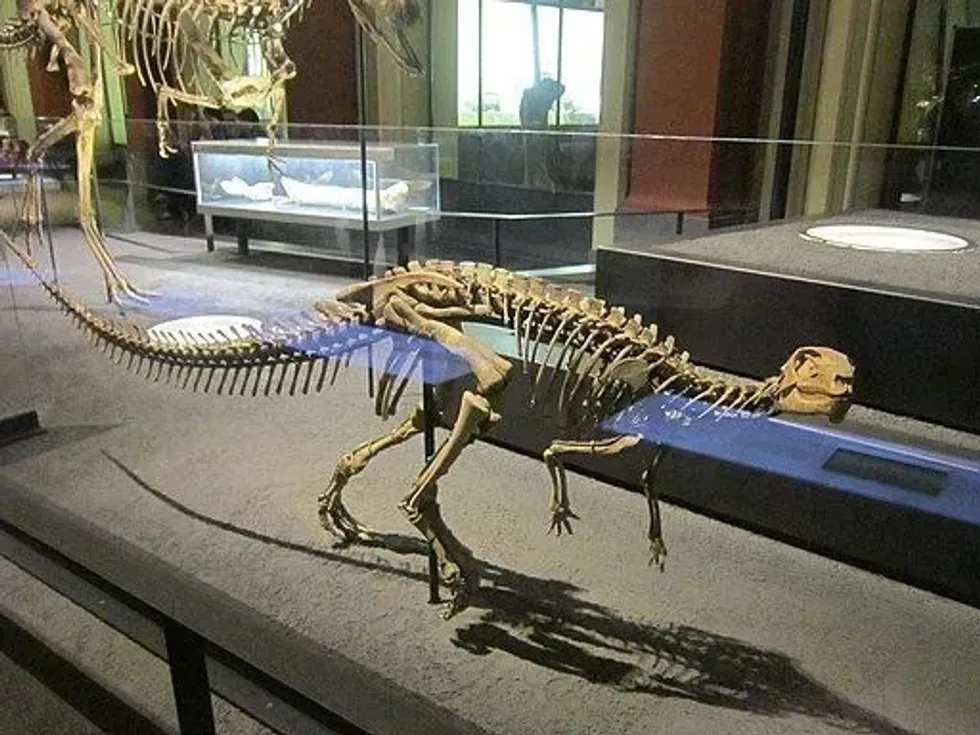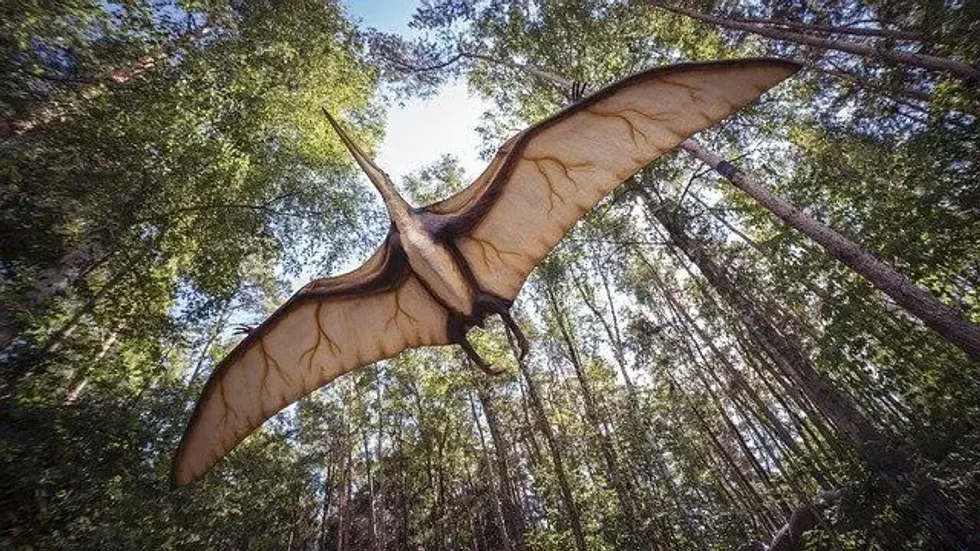The greater flameback is also widely known as the Chrysocolaptes lucidus species. It is found in the Indian region along the foothills of the Himalayas.
These birds, with their long neck and yellow to dark brown color, are very much drawn to open forests with a large population of trees.
With a range covering southern Asia to the Philippines, these large golden-backed woodpeckers can be found humming their songs across these regions.
Females of this species appear different from males in various aspects. The greater flameback is also known as Malherbe's golden-backed woodpecker, or a large golden-backed woodpecker and a greater flameback often carries a golden yellow to dark tint alongside its wings and has white to dark makings under the body.
It's relatively easy to tell the difference between males and females of this species. A greater flameback (Chrysocolaptes guttacristatus) male comes with a signature red crown and the rump is red in males, but the tail is black in both sexes.
Females have light brown underparts with a dark brown back and wings. Keep reading to learn all about the greater flameback range, habitat, diet and more!
If this article sparks your curiosity, check out our saker falcon and prairie falcon pages to learn more about other birds of the world.
Greater Flameback Interesting Facts
What type of animal is a greater flameback?
A large golden-backed woodpecker (or Malherbe's golden-backed woodpecker), which is also known as a greater flameback (Chrysocolaptes guttacristatus), is a type of bird. It belongs to the category of Aves like all other birds.
What class of animal does a greater flameback belong to?
Malherbe's golden-backed woodpecker belongs to the Aves class.
How many greater flamebacks are there in the world?
This golden-backed woodpecker relies on wooded areas and forests to live in and these birds with unmarked golden yellow backs do not yet have a fixed population count. It's estimated that this greater goldenback large golden bird has a population of around 5,000-10,000 across the general greater flameback habitat range.
Where does a greater flameback live?
The typical greater flameback habitat range covers several countries. The habitat range for these birds with light brown underparts and dark brown back feathers covers Bangladesh, India, Bhutan, Nepal, and some eastern parts of China. Various subspecies of these birds are also found in similar regions.
What is a greater flameback's habitat?
Due to constant human encroachment, this greater flameback (Chrysocolaptes guttacristatus) bird with a long neck is facing habitat loss. Nevertheless, a greater flameback bird prefers to live in open forest areas with healthy vegetation. This greater goldenback large golden-backed bird also thrives in mangrove forests.
Who do greater flamebacks live with?
In their natural habitat, these birds live with various subspecies, such as the Indian peafowl. The Indian roller is also found in a greater flameback's natural habitat.
How long does a greater flameback live?
These yellow to dark brown birds can live for 4-11 years.
How do they reproduce?
There are various subspecies of these birds and the mating season varies for each subspecies. Although for a greater flameback (Chrysocolaptes guttacristatus) the average clutch size remains between three to four eggs. Courtship behavior is very unique among these large golden-backed woodpeckers and they often drum on trees as part of their courtship ritual.
What is their conservation status?
Its status is Least Concern as this greater goldenback large golden bird is not under any major threats currently. However, habitat loss is becoming a concerning topic for this species, as it is for many birds of the world.
Greater Flameback Fun Facts
What do greater flamebacks look like?
A greater flameback (Chrysocolaptes guttacristatus) has a pointy beak which helps this species to cut through the tough barks of trees and to find insects. These birds have four toes and a golden yellow to dark brown back.
The rump is red and the tail is considerably long. In females, the underpart is white with dark markings and they have a brown back and wings carrying their signature golden color.
How cute are they?
All the birds in this species are very cute, and a greater flameback is indeed a beautiful sight for the eyes These birds are stunning, they are white with dark markings among other colors (such as red) and the tail they have is beautifully long!
How do they communicate?
Communication is a very important skill for all birds of the world. For these golden-backed woodpecker or Malherbe's golden birds, communication is key during courtship. Their main form of communication involves drumming on tree barks.
How big is a greater flameback?
A healthy greater flameback is similar in size to a northern spotted owl and slightly bigger than a little blue heron.
How fast can a greater flameback fly?
Greater flameback (Chrysocolaptes guttacristatus) birds can reach a good flight speed, almost equal to the average bird of its weight.
How much does a greater flameback weigh?
An adult greater flameback (Chrysocolaptes guttacristatus) can weigh anywhere around 1-1.25 lb (0.45-0.68 kg).
What are their male and female names of the species?
Both sexes of this species are referred to with a common name: the greater flameback.
What would you call a baby greater flameback?
Depending upon the age of the young birds, you can either refer to them as nestlings (young birds who are still in the nest) or hatchlings (young birds that have just hatched from the egg).
What do they eat?
Their pointy beak helps them to find plenty of insects from within the barks of trees. A greater flameback's diet mostly comprises insects, fruits, seeds, and some nuts.
Are they dangerous?
This species is not dangerous to humans at all. They are very active and can provide lots of entertainment to you and your family!
Would they make a good pet?
A bird from this species is usually not kept as a pet as they are very loud and thrive best in the wild.
Did you know...
The Chrysocolaptes lucidus is often confused with its neighboring subspecies, the black-rumped flameback. An easy way to distinguish them is to understand that the greater flameback has a red crown and its tail is black. On the other hand, a black-rumped flameback has very dull unmarked golden yellow wings and a dark mustache.
This greater goldenback large golden-backed bird has a very long tongue, at almost 4 in (10.16 cm) in length!
There are approximately 180 species of woodpeckers across the world.
Different types of flameback
Flamebacks have a variety of subspecies with different behavioral traits, courtship habits, and diet habits. Some common species of flamebacks are the black-rumped flameback, the common flameback, the white-naped flameback, the crimson-backed flameback, and the Himalayan flameback.
Greater flameback vs common flameback
In contrast to what their name suggests a common flameback is very hard to find, often harder than a greater flameback! The male common flameback has a red crown, while the female has a black color crown.
A greater flameback is relatively easier to find as it can sometimes be found in urban areas. These species have spots starting from their throat to all the way to the wings.
Here at Kidadl, we have carefully created lots of interesting family-friendly animal facts for everyone to discover! Learn more about some other birds from our rainbow lorikeet facts and Nicobar pigeon facts pages.
You can even occupy yourself at home by coloring in one of our free printable greater flameback coloring pages.










